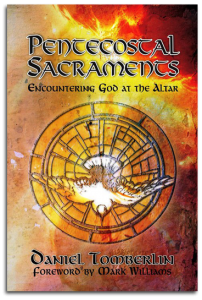The Pentecostal and liturgical movements are among the most important transformative renewal events of the 20th century. For the most part, their mutual influence has been marginal and minimal, with Pentecostals seeking to restore biblical worship devoid of dead ritualism, and the liturgical movement drawing first on the ancient patristic heritage and more recently on the rich cultural diversity of the Church catholic. This volume will be welcome addition to the emerging literature that seeks to discern the Spirit in both and their mutual enrichment.
The Pentecostal community inherited an “ordinance” approach to the dominical two sacraments in the evangelical Protestant canon, many adding foot washing. This author treats these three, adding anointing and baptism in the Holy Spirit, which those familiar with the sacramental heritage in theology and the liturgical practice of the classical Pentecostal churches will immediately recognize. These are included in this Pentecostal theological treatment, if not yet to the ecumenical canon of sacramental thinking. In the context of foot washing the author treats confession, reconciliation and ministry, all important sacramental rites in the wider ecumenical discussion.
The book is addressed primarily to the Pentecostal reader, but his argument, biblical exegesis, and ritual suggestions will be of much wider ecumenical interest. He makes a strong case for the sacramental character of the five rites explored in detail here, as means of grace instituted by Christ. His argument rests on a Pentecostal theology of encounter and the experience of the Holy Spirit rather than a more familiar scholastic concern about causality, validity and ministerial succession. He does, however, deal with the Baptismal formula, a contested issue among Pentecostals, and makes a strong case for a robust Trinitarian theology, and a higher ecclesiology than one often finds in evangelical Protestant preaching and practice. Because of his audience, his biblical arguments are extended with arguments, especially for sacramentality from Pentecostal sources; and new to many Pentecostal readers, patristic sources with their strong pneumatology, especially Augustine.
The volume is divided into seven chapters, with preface and afterward. Five treat of the sacraments on which he focuses his biblical, patristic, Pentecostal and pastoral development: baptism in the Holy Spirit, water baptism, the Lord’s Supper, foot washing and anointed touch. An introductory chapter provides a uniquely Pentecostal theological context and sacramental principle for his development: “Encountering God at the Altar.” The Pentecostal “altar” is not so much an artifact of church architecture as it is a spiritual space, and when imagined concretely, the entire sanctuary and front of the church where the faithful gather at the altar call, anointing, blessings and the Lord’s Supper. The theology of altar is developed with particular attention to the covenantal encounters of the Hebrew Scripture and their disclosures of God’s power and glory in the midst of the community. It is this deeply biblical heritage of God’s encounter with his people that lays the ground work for his development of New Testament and patristic understanding of the sacramental character of God’s action in the Church and in the rituals of the community.
The second introductory chapter lays the groundwork of a Spirit-filled sacramental theology by explicating a doctrine of grace, its mediation and its relationship with the church. It is in this chapter that he lays out the Pentecostal five-fold understanding of Christology: Christ as savior, healer, sanctifier, Spirit baptizer and coming King. Here he recounts the heritage of the classical Pentecostals in the renewal of the church through the ages, from patristic times; and in the American revivals, emphasizing their Eucharistic and sacramental roots. For the Pentecostals to realize their sacramental identity they will need to recapture their heritage, proximate and through the 2,000 years of history. This volume will be useful for ecumenical Christians to begin to see the contribution of the Pentecostal churches to the renewal of the church on the pilgrimage toward unity, and a sense of their more complex history, with its openness to ecclesiological and sacramental concerns.
This is an early contribution to what promises to be an important ecumenical project, and adds to a growing literature on Pentecostal worship, systematic theology and ecclesiology. Even its limitations are a tribute to its importance for generating more specialized and detailed study.

